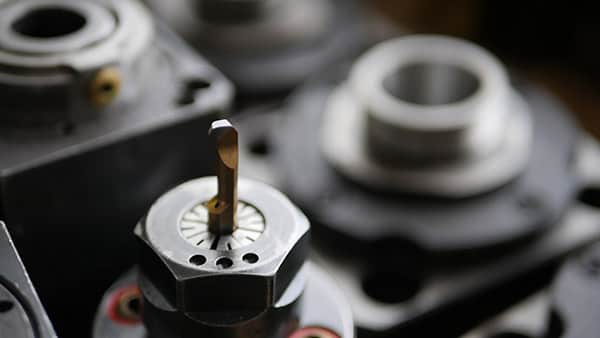Intro
CNC turning is one of the best ways to make custom parts out of cylindrical bar stock. You might be wondering what CNC turning is, how it works, why people use it, and how it can benefit you. Not to worry, our professional machinists at Rapid Axis put together this introduction to CNC turning, and we’ll tell you everything you need to know.
What Is CNC Turning?
To understand CNC turning, we should first explain what a CNC is. CNC stands for computer numerical controls. It’s a fancy way of saying that the machine uses computers to digitize and potentially automate a lot of the process.
This means that the machine operator can type in numbers rather than manually going to certain positions. It allows for more accuracy, faster projects, and more reliable repeatability.
A turning machine uses cutting tools against a rotating piece of material to take away material until a final part is achieved. Typically, a CNC lathe is used to turn parts.
To better visualize a CNC turning machine, imagine a chess piece. That piece started out as a cylindrical block of material. The block was probably placed in a lathe chuck, spun quickly, and had tools push against the block to remove features until a pawn was created.

How the Turning Station Works
A turning station (or lathe) can use wood, metals, or even plastics. With a standard turning machine, material is put into a chuck that is tightened down to hold onto the material with a lot of grip. The entire chuck then spins at a preset and variable speed (typically thousands of RPM but it can be up to 15,000 RPM).
Opposite the chuck is a place to position and move cutting tools. It’s important to point out that the material is rotating quickly but is typically stationary in its position. The tool is moved in order to perform different cuts and feature creation.
A basic CNC turning machine will allow the tool to move in the X, Y, and Z directions. More complicated stations will offer live tooling — that’s when the tool can rotate about different axes and the cutting head can even swap out tools automatically.
Since the cutting tools are much tougher than the material in the chuck, material will be stripped away. A bladed tool can be pushed into the material, removing a predetermined amount of material.
Uses for CNC Turning
Due to the nature of a CNC turning machine, it’s typically used to create cylindrical parts that are symmetric. However, more complicated CNC turning stations with multi-axis functionality can create asymmetric features like holes and notches.
We mentioned a chess piece earlier, and that can be used as a great way to imagine the uses for a CNC lathe. With a pawn, you’ll notice different geometries, tapers, jutting material, a rounded part, and a flat end. All of these features can be made from a single program on a CNC lathe. A CNC turning station can:
– Round a rod
– Add a chamfer to a rod
– Change the outer diameter to a very accurate dimension
– Change a diameter with high levels of consistency across the length of the material
– Cut a rod to multiple certain, specific lengths
– Add external threads to a rod
However, that chess piece only shows the functionality of CNC turning in regard to external features. You can also use a lathe to turn interior features. The rotating piece in the chuck can be pushed against tools to create:
– Threaded holes
– Internal through holes
– High-precision holes
– Internal chamfers, radii, or breaks
Although square stock material can be held from specialized chucks, lathes are typically reserved for cylindrical pieces.
Why People Choose CNC Lathes Over Mills
You might be wondering why you would use CNC turning instead of CNC milling. After all, a CNC mill can easily create the same features and geometries that a CNC lathe can. The big difference boils down to efficiency, accuracy, and time spent.
A mill can be programmed to make small circles with its cutting head, resulting in an outer diameter of 1”, for example. Depending on the width, length, and height of the stock material, this program could take hours. A lathe using the same stock material can turn the block down to a 1” outer diameter in mere minutes.
It’s a lot harder for a spinning tool to reliably move and cut around a rod than it is for a stationary blade to cut a spinning rod.
To simplify, CNC turning is quicker, more repeatable, and more accurate than CNC milling rounded stock material.
Typical CNC Turning Tolerances
When it comes to tolerancing, you might be impressed by what a CNC turning station can achieve. Typically, 5 mils (0.005”) is easy to repeatably achieve. With precision machine shops, that tolerance can shrink down even more which is good news for people designing assemblies.
Conclusion
CNC turning is a great way to get cylindrical parts custom-made. If you want to get high-quality CNC turned parts, you need to pick the right machine shop. At Rapid Axis, our goal is to give you the best parts thanks to our great CNC turning stations and experienced staff. Reach out today to get a quote and have your parts made.

